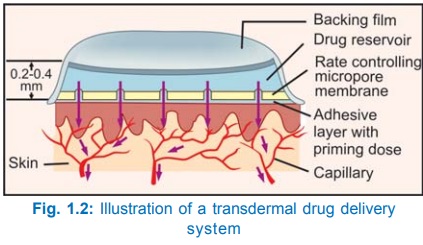Transdermal Therapeutic Systems
| Home | | Pharmacology |Chapter: Essential pharmacology : Introduction And Routes Of Administration
These are devices in the form of adhesive patches of various shapes and sizes (5–20 cm2) which deliver the contained drug at a constant rate into systemic circulation via the stratum corneum.
TRANSDERMAL THERAPEUTIC SYSTEMS
These are devices in the form of adhesive patches of
various shapes and sizes (5–20 cm2) which deliver the contained drug at a
constant rate into systemic circulation via the stratum corneum (Fig. 1.2). The
drug (in solution or bound to a polymer) is held in a reservoir between an
occlusive backing film and a rate controlling micropore membrane, the under
surface of which is smeared with an adhesive impregnated with priming dose of
the drug. The adhesive layer is protected by another film that is to be peeled
off just before application. The drug is delivered at the skin surface by
diffusion for percutaneous absorption into circulation. The micropore membrane
is such that rate of drug delivery to skin surface is less than the slowest
rate of absorption from skin. This offsets any variation in the rate of
absorption according to the properties of different sites. As such, the drug is
delivered at a constant and predictable rate irrespective of site of
application: usually chest, abdomen, upper arm, lower back, buttock or mastoid
region are utilized.

Transdermal
patches of GTN, fentanyl, nicotine and estradiol are available in India, while
those of isosorbide dinitrate, hyoscine, and clonidine are available in other
countries. These have been designed to last for 1–7 days in case of different
drugs and are becoming increasingly popular, because they provide smooth plasma
concentrations of the drug without fluctuations; minimize interindividual
variations (drug is subjected to little first pass metabolism) and side
effects. They are also more convenient—many patients prefer transdermal patches
to oral tablets of the same drug; patient compliance is better. Local
irritation and erythema occurs in some, but is generally mild; can be minimized
by changing the site of application each time by rotation. Discontinuation has
been necessary in 2–7% cases.
